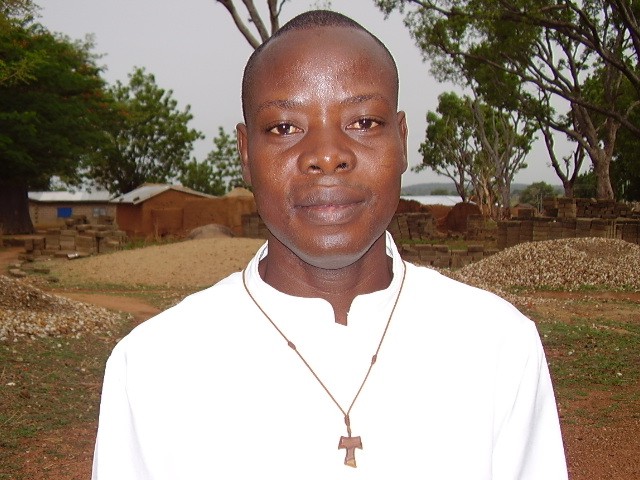

Fr. Isaac Akapata (Bongo, U.E.R.)
Biuk - A Village with Bulsa Traditions
LOCATION OF BIUKLAND & SETTLEMENTS
Geographically Biuk, Biu
or Biung (10° 46.6' N; 1° 6.3' W) is located south of Navrongo, a distance of twelve kilometres along the
Navrongo-Kologo-Naa(ga) road (see map). Biukland is further away from this road, about four
kilometres westward. On most maps, only Kologo, Naa(ga) and Chuchuliga towns are located.
These are the neighbouring towns to Biukland. The main reason is that the above-mentioned
villages are on roads
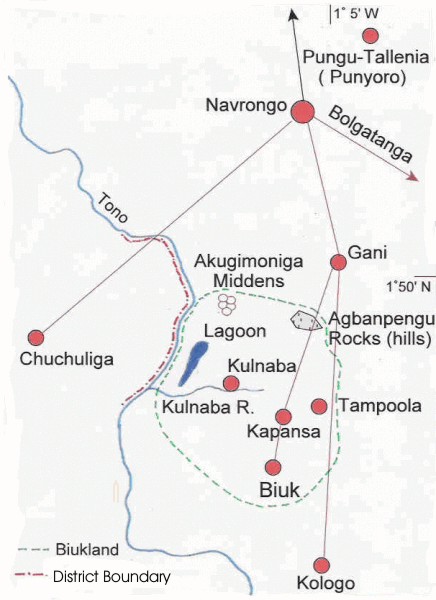 and
were also centres of traditional importance and authorities. The second reason
given by the late Bishop Rudolph Akanlu is that Biukland was comparatively
smaller than those villages or towns, and in the colonial times, politically,
Biukland was considered to be part of Kologo in the Kasena-Nankani District in
the Upper East Region. Apart from Kologo, Naa(ga) and Chuchuliga, which
are mentioned and can be found on many maps of the Region and Districts of Upper
East, Biukland is unknown to the written sources we have contacted for this
paper.
and
were also centres of traditional importance and authorities. The second reason
given by the late Bishop Rudolph Akanlu is that Biukland was comparatively
smaller than those villages or towns, and in the colonial times, politically,
Biukland was considered to be part of Kologo in the Kasena-Nankani District in
the Upper East Region. Apart from Kologo, Naa(ga) and Chuchuliga, which
are mentioned and can be found on many maps of the Region and Districts of Upper
East, Biukland is unknown to the written sources we have contacted for this
paper.
ORIGIN AND HISTORY OF BIUK
The first man said to have started the village settlement of Biuk was one Avobga . His name is of doubtful origin, and means "from cave or ground". It is speculated that Avobga was most likely a Bulsa or Nankaniga. Others say he was a Kasen – Yuuliga, but this is doubtful since Kasem is not widely spoken in Biuk. According to oral traditions, he had a family dwelling in a thick forest called Akugimoniga. The place still exists and is found near Abelnaba (Akulnaba, Kulnaba) River, north of Biuk. Its is a midden believed to be the abode of the souls of the Biu(k) descendants. There is a secret and a mystery surrounding it, which they are not ready to disclose apart from the one given above.
It was a hunter, who discovered the first Biuk settlements. He was from the village of Gani or Ganea (10° 29.5' N: 1° 4.4' W), a typical Nankane village, nearly in the middle between Navrongo and Biuk. The man, according to oral history, shot a bush cow and wounded it. It ran wild into the bush and escaped. He decided to trace it, hoping and knowing surely it would die. He followed the footprints of the game to the dwelling site of the Biuk man in the thick forest. To his surprise he heard a female voice that was scaring birds from a farm nearby. He went in the direction of the voice and discovered a girl on the farm.
After exchanging greetings with the girl he asked for her father and she took him to her parents in a cave in the forest. He greeted the father of the girl and told him of his search for a game he had shot and traced. This had led him to his territory. However, the hunter from Gani was worried and became desperate that the coming rain would obliterate the footprints of the game, making it difficult to search for it.
Upon this the Biuk man assured his visitor that he would disrupt the rain by some spells and the search could continue. An agreement was reached between the two to share the game equally if found. The Biuk man fouled the rain and the two men searched for their game. It was found south of the Biuk man’s farm. The sharing was done according to the agreement reached between them. By the time they finished sharing it was dark and the Gani man could not go back to his country. The Biuk man hosted him in his cave and the following morning he left for his country in Ganiland.
The Gani man was impressed with the hospitality and cooperation of the Biuk man. So he invited him to visit his country, Ganiland. Meanwhile when he got to his country he told his sister everything that he encountered in his hunting expedition and his meeting with a man from another country south of them. It is said he suggested to his sister to marry his friend from Biukland when he visited them the next time. Though the Gani man did not know his new friend so well he explained to his sister that “he was somebody.” After having waited in vain for the Biuk man’s visit, he went to Biukland the second time to find out from his friend if he knew the way to Ganiland. It was during this second visit that the Biuk man obliged him and went to Ganiland. It amazed him to see the kind of houses and huts that were constructed in Ganiland. He learnt from his friend how to build such houses and huts for his native Biukland.
Relationship between the Biuk man and Gani man
The beginning and development of the relationship between the two men was the exchange of visits and subsequent marriages of their sisters to each other. When the Biuk man visited his friend in Ganiland he married his sister and stayed there for sometime before going back to Biukland. The Biuk man also gave his sister in marriage to the Gani man. The exchange of visits continued and the ties between the two families strengthened.
It is said that one day the Gani man, still curious about the origin and background of his in-laws, asked his wife (the sister of the Biuk man) to tell him how they came to stay in a cave in Biukland. His wife did not tell him but simply said they came from the ground, a sacred cave and had been brought up by a crocodile. The true origin of his wife and brother in-law remained a mystery.
The next aspect of their relationship was the demarcation of their countries’ borders. The Biuk
man had started to extend his farms to Ganiland. As a result of this the Gani man, now an in-law,
suggested that they should delimitate their respective borders to avoid a possible encroachment in
the future. Consequently, they went out to demarcate their borders. The Gani man used tied grass
and shrubs as his landmarks. The Biuk man, on the other hand, followed him and claimed all the
remaining land. The Biuk man used trees and rocks for his border posts.

However, in the dry season, bush fire razed the vegetation to ashes, leaving only trees and rocks behind. In the rainy season they went out to farm and the Gani man found it difficult to locate his landmarks. There was need to demarcate the land again. It was at this point that the Biuk man took a large portion of the Gani man’s land because the latter’s landmarks were difficult to locate. The Biuk man claimed the Gani man’s land stretching from a range of rocky hills called Agbanpengu or Agantanga – meaning Gani rocks (10° 48.9' N; 1° 4.8' W). All the land south of these rocky hills belonged to Biuk. These events marked a turning point in their relationship.
The relationship started to break as a result of family disagreements. The Gani man quarrelled with his wife and hailed insults on her mysterious background and origin. Her profound hurt led to their separation and she returned to Biukland with her young son. The Gani man was afraid to follow up on his wife and child from the Biuk man. He never got them back. As a result the woman and her child became members of the Biuk man’s family. Meanwhile, the Biuk man and his wife (the Gani man’s sister) had children and established a stable family. It is said that they stayed together till her death and the man married a second wife from another village, Achulaland (Chuchuligaland) . The Biuk family consisted of his first wife and children, his second wife, his sister and nephew, son of the Gani man who was older than his own children.
The Gani man – origin and background
In my research it was found that the Gani man did not actually come from Gani. According to a second oral history source he migrated to Ganiland from a place called Tallenia, where his father came from. Gani was his maternal home. It has been ascertained that the Tindana (Nankane name for Buli Tengnyono, landlord) of Ganiland is a descendant of this man. The Tindana’s house in Tallenia is known as Atanpugna or Atanpugnia. A casual interview with an elderly anonymous man related to the family in Pungu (village in Navrongo-North-East) confirmed the story. The language of this man is known to be Yuuli (Kasem). He also spoke the Nankane dialect. It has been established that there is a relationship between the people of Gani and Pungu Tallenia, who are the first indigenous people of Kasenaland, present day Navrongo traditional area.
Cardinall’s Report
A.W. Cardinall, a District Commissioner of the colonial administration, wrote about his first contacts and experiences in the Northern Territories. In chapter two of his book he attempted a historical and ethnographical documentation of the natives. Of interest is the following passage:
The story of Paga is that they came from Kibelli. Three brothers had fought against their family and been worsted. They had to flee, and with them went their sister. These three came to Paga and founded families there, and gave their sister that part of the land, which is called Paga-bru. Gania section of Navarro was founded by a hunter from Po. He had wounded a buffalo, which fell down at Kulnaba, its horns excavating the lagoon, which is found there. While admiring his kill there came to him a man of Biung. The two made friends, and later the Biung man gave his daughter to him from Po, and land near where the beast was slain. Thus came Gania, but since that time the family has moved a little to the east, but their old dwelling-places are still known and can easily be seen by the middens in the bush near Kulnaba.
Thus private quarrels, family quarrels, tribal quarrels have practically everywhere peopled the land, with here and there a community founded by a hunter or some individual of great prowess. But it is interesting to note that the sections named Biung (a word of forgotten meaning) nearly always lay claim to the fact that they themselves were from the earth and that their ancestors dwelt in holes in the ground. I have never been able to persuade one of these people to show me these caves or holes, although, both at Navarro and at Zuarangu, Biung sections exist.
(A.W. Cardinall, The Natives of the Northern Territories of the Gold Coast. Their Customs, Religion and Folklore. 1920, p. 13.)
Cardinall’s account demonstrates and confirms early attempts to research villages like Biuk and the difficulties encountered. My research is equally inconclusive. The origin of Biuk is not clear until further research is able to throw light on the matter. The only certainty is that some parts of Biuk, for example, Kapaansa, Tampoola and Goonsa, have Nankansi origin.
ETHNIC AND SOCIAL ORGANISATION OF BIUKLAND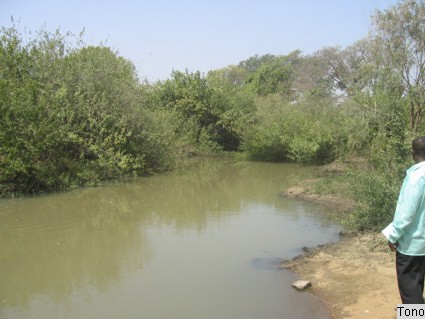
Kasena and Nankani people identify Biukland traditionally as a Bulsa village. The Kasena call people from Biukland, Biina and their language, Tiiburi. This is because Buli is the language widely spoken in Biukland. Also, the customs and culture of the village are not identical but similar to those of the Bulsa in Sandema and Wiaga (Bulsa District).
Someone familiar with the geography of the villages and towns in the Upper East Region would find it difficult to understand why Biuk, administratively, is in the Navrongo District and not within the Bulsa District. This was a colonial administrative demarcation. There is a river (Tono) dividing Biukland and Chuchuligaland though the two neighbouring towns are only 6 miles away from each other. Unable to put a bridge over this river it was prudent to place Biukland under the Kasena-Nankani district administration.
Gane-Kapaansa & Tampoola Settlements
To the north of Biuk there are two smaller settlements – Gani-Kapaansa, and Tampoola. These
villages are of Nankansi origin though they are located in Biukland.
The people have been integrated and speak Buli in addition to the Nankani language. These are
immigrants from Gane in Navrongo. Acculturation is fast taking place between the three villages
because of inter-marriages and frequent interactions with each other. The total population and the
number of compounds stand at 3,540 and 325 respectively (Source: Navrongo Health
Research Centre, Navrongo Demographic Surveillance Survey, computer centre).
Akulnaba village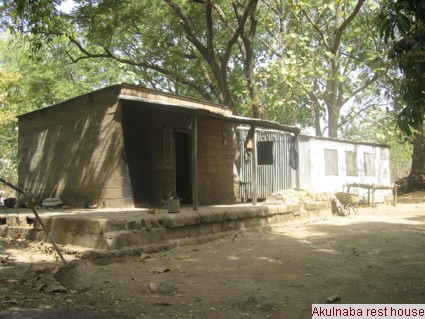 (10° 48.4' N; 1° 7.1' W)
(10° 48.4' N; 1° 7.1' W)
Another settlement community is ‘Akulnaba village,’ located northeast of Biukland. The settlement is named after the Akulnaba River or lagoon. These people first settled on the upper course of the lagoon for farming crops and livestock. It was a project initiated by a missionary priest, Rev. Fr. Josef Grosskinsky (Missionaries of Africa). His resthouse, now a farmhouse, can still be seen on the eastern bank of the lagoon.
The above settler villages – Gani-Kapaansa, Tampoola and Akulnaba, are in the Biuk statistical records and demographic figures. From the ethnic composition of Biukland one can see a part of it speaking Nankani because of these settler villages or communities, and others who also speak Buli because of their Buli origin. Our main interest here is to take a look at the social organisation of the Bulsa natives of the Biuk village.
Indigenous Clans and Sections
According to traditional lineage division, the native Biuk settlement is divided into clans, sections and lineages. On this regard the following eleven clans and their respective clan-heads have been identified.
|
Clan |
Clan-heads |
|
|
1 |
Agyenta-Yire |
Anyeesibanga |
|
2 |
Ajogi-Yire |
Akabigirah |
|
3 |
Azinsa-Yire |
Apeegire |
|
4 |
Doosindema-Yire |
Akuutosi |
|
5 |
Jaogu-Yire |
Awumbadige |
|
6 |
Awaagila-Yire |
Ayeeribey |
|
7 |
Goonsa-Yire |
Azibukah |
|
8 |
Afoene-Yire |
Ayomah |
|
9 |
Ateensi-Yire |
Akuumkatiim |
|
10 |
Ayiigi-Yire |
Akuunta |
|
11 |
Akuuli-Yire |
Akeeli |
There is an overlord (Teŋnyono, Teŋ-dana) over the whole village. His house is Agyenta-yira, where community matters and affairs are deliberated and decided. Most of these affairs and issues include funerals, sacrifices, marriage cases, farming taboos and sanctions, land disputes and many others.
Apart from these clans there are sections, which include: Biuk-Sensa, Biuk-Koodema, Biuk-Jaogu, and Biuk-Goonsa. There seem to be fictitious kinship-relations among the eleven clans and even the sections in Biukland. All these sections together with the settler communities form one Biuk- village. Due to its location and as a result of its subordination to the Kasena-Nankani District, by the colonialists, the Biuk village has become part of that district and belongs to the Biuk-Kologo-Naa(ga) Area Council. This is the Area Council known as Navrongo-South.
ECONOMIC ACTIVITIES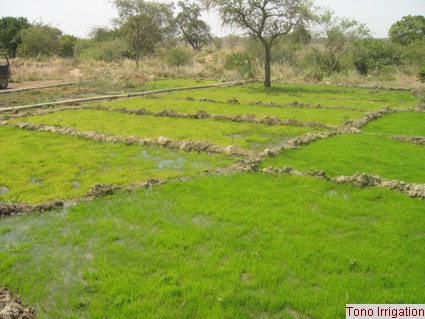
Biukland is an agrarian settlement with vast fertile lands for the cultivation of crops like maize, millet, guinea corn, rice, beans, groundnuts, sweet potatoes (Ipomea batatas) and vegetables. Livestock and small-scale household poultry farming is done alongside subsistence farming in the rainy season. With the construction of the Tono Irrigation Dam Biukland has the largest land acreage for irrigation farming both in the dry and rainy seasons.
Of the existing women’s groups in the village the only active one is the Sensa Women’s Association, a self-supporting income-generating group. In 1997 the now defunct December 31st Women’s Movement acquired and installed a grinding mill and a rice miller. There used to be one centralised market in Biukland for commercial and economic activity. However, in the 1990s people stopped patronising the market because of a disagreement over its location. As a result there is no longer a central market. But there are two centres (stations) where one can buy essential food items without having to go to Navrongo market. These centres are growing into market centres even though there is no management control.
This research has not revealed any commercial pottery activity in the village. Some women have pottery skills but not for commercial purposes. This is the case with basket and mat weaving as well. Women engage in these activities for subsistence. I am aware of only one blacksmith family. This trade seems to be dying out because of the reluctance of the younger generation to acquire the skill.
RELIGIOUS BELIEFS AND PRACTICES IN BIUKLAND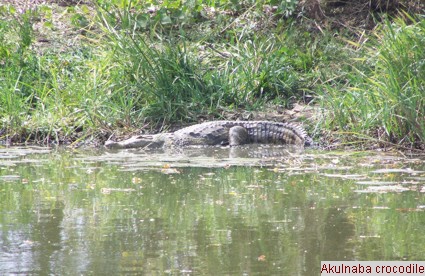
Until recent times religious beliefs and practices in Biukland were based mostly on ancestor worship. Most people worship idols and shrines (bogulu-kaabka).
There are clan idols and shrines and personal idols and shrines that require devotion. These deities are contacted with the help of diviners (baanoaba) and sorcerers (nyaaroaba). Divination and sorcery are prevalent in Biukland. Apart from the clan, family or personal idols in the village, there are two main deities widely acclaimed by the natives. These "deities" are: “Naawon” and “Teŋa” – the Supreme Being and Earth Goddess respectively. The Supreme Being provides security and protection, the Earth Goddess crop fertility and production. The most important shrines are located in Agyenta-yire and have their priests who offer annual sacrifices to them. Many shrines are intimately associated with the crocodile, which is a totem for the whole Biukland. The living reptiles are in the Akulnaba River/lagoon and regularly visit the Agyenta-yire’s compound.
Christianity & Islam
The first Christian denomination to come to the village was the Catholic Church. The Missionaries of Africa - White Fathers - came from Ouagadougou to Navrongo in 1906. They extended their Christian activities to the village in the 1970s and converted a few people. It was difficult for the converts to walk to the Navrongo Cathedral Church (Now Minor Basilica), a distance of 24 km in and out, for prayers and worship on Sundays.
However, the Presentation Brothers of Mary, also stationed in Navrongo, continued to reach out to the village and made more converts. In 1972 they built a clinic and provided hand-dug wells in the village. A primary school was also built. In the 1990s serious pastoral attention was given to the Biukland by the late Rev. Fr. Joseph Awiah and later Rev. Fr. (now bishop) Dr. Lucas Abadamloora.
In 1995, Biukland was formally created an outstation of the Navrongo Mission. In the same year a young student from the village entered the Major Seminary in Tamale to be trained for the priesthood. In August 2003, he was ordained a priest, the first Catholic Priest from Biukland. Other Christian denominations in Biukland include: Church of Pentecost, Assemblies of God and one spiritual church, ‘Nankaba.’ These churches do not have as much following as the Catholic Church. I have not come across any organised Muslim community in Biukland though there seems to be a few people who are sympathetic to Islam. There are no mosques in Biukland.
CONCLUSION
This is a modest attempt to research the history of Biukland in relation to its neighbouring villages. More research needs to be conducted for a conclusive knowledge of Biukland. I hope this will be an ongoing project. Thanks to Dr. Franz Kröger and Mr. Andreas Fechner for their interest.